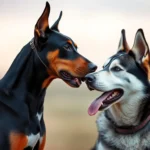
Introduction
Understanding dog breeds is essential for anyone considering adding a furry friend to their family. Each breed comes with its unique characteristics, temperaments, and care needs. Among the diverse array of dog breeds, the Drever dog stands out as a unique and versatile companion. Known for their hunting abilities and affectionate nature, Drevers are a breed that deserves attention from potential owners. This article will explore the fascinating history, physical characteristics, temperament, health considerations, and care requirements of the Drever dog, providing a comprehensive guide for those interested in this breed.
History of the Drever Dog
Origins
The Drever dog has its roots in Sweden, where it was originally bred as a hunting dog. Its history dates back to the 1940s when it was developed to assist hunters in tracking and retrieving game, particularly small deer and hares. The breed’s name, “Drever,” is derived from the Swedish word for “track,” reflecting its primary function. The Drever dog is thought to be a result of crossbreeding between the Swedish Elkhound and various other small hound breeds, resulting in a dog that is both agile and tenacious.
Development
Over the years, the Drever dog has evolved to adapt to the changing needs of hunters. Breeders focused on enhancing specific traits such as scenting ability, stamina, and temperament. Although primarily used for hunting, Drevers have also gained popularity as family pets due to their friendly nature and adaptability. The breed was officially recognized by the Swedish Kennel Club in 1947, solidifying its status as a distinct breed.
Physical Characteristics
Size and Weight
The Drever dog is a medium-sized breed, typically standing between 12 to 15 inches tall at the shoulder. Their weight usually ranges from 25 to 35 pounds, making them a manageable size for both urban and rural living.
Coat and Color
Drevers have a short, dense coat that is well-suited for outdoor activities. The coat type is weather-resistant, which helps them thrive in various climates. Common color patterns include a mix of tan, red, and white, with some variations featuring black markings. The combination of colors gives the Drever dog a distinctive appearance that is both attractive and functional.
Distinctive Features
One of the most distinctive features of the Drever dog is its long, floppy ears and expressive eyes. Their ears hang close to the head, enhancing their keen sense of hearing, which is vital for their hunting capabilities. Additionally, Drevers have a strong, muscular build that supports their stamina and agility in the field.
Temperament and Personality
General Temperament
The Drever dog is known for its friendly and outgoing temperament. They are affectionate with their families and often form strong bonds with their human companions. Drevers are typically good-natured and exhibit a playful demeanor, making them an excellent choice for families.
Social Behavior
Drevers are social animals that enjoy being around people and other pets. They generally get along well with children, making them a great addition to family households. Their friendly nature allows them to thrive in social settings, whether it be at home or on walks in the park.
Intelligence and Trainability
The Drever dog is intelligent and eager to please, which makes training relatively straightforward. They respond well to positive reinforcement techniques and enjoy engaging in activities that challenge their minds. Basic obedience training is essential, and early socialization is recommended to ensure they grow into well-rounded adults. Tips for training a Drever dog effectively include consistent commands, patience, and incorporating play into training sessions.
Health Considerations
Common Health Issues
Like all breeds, the Drever dog is prone to certain health issues. Some common concerns include hip dysplasia, ear infections, and obesity. Regular veterinary check-ups can help identify and manage these health problems early.
Preventative Care
Preventative care is crucial for maintaining the health of a Drever dog. Regular vaccinations, dental cleanings, and annual health screenings are recommended. Additionally, monitoring their weight and diet can help prevent obesity-related issues.
Lifespan
The typical lifespan of a Drever dog ranges from 12 to 15 years, depending on their overall health and care. Factors influencing longevity include genetics, diet, exercise, and regular veterinary care.
Care and Maintenance
Grooming Needs
The grooming needs of the Drever dog are relatively low due to their short coat. Regular brushing is recommended to remove loose hair and reduce shedding, especially during seasonal changes. Bathing should be done as needed, typically every few months or when they become particularly dirty.
Exercise Requirements
Drevers are active dogs that require daily exercise to maintain their physical and mental well-being. A minimum of 30 to 60 minutes of exercise is essential, which can include walks, playtime in the yard, or engaging in dog sports. Activities that stimulate their hunting instincts, such as scent games, can be particularly enjoyable for them.
Nutrition
Providing a balanced diet is crucial for the health of a Drever dog. High-quality dog food that meets their nutritional needs is essential, with a focus on protein and healthy fats. It’s important to adjust their food intake based on their activity level and age to maintain an ideal weight.
Ideal Living Conditions
Suitable Environments
The Drever dog is adaptable and can thrive in various living situations. However, they do best in environments where they have access to outdoor space for exercise and exploration. Whether in a city apartment or a rural home, providing opportunities for physical activity is vital.
Space Requirements
While the Drever dog does not require vast amounts of space, they do benefit from a home with a yard or access to parks. Regular walks and playtime are essential for their overall happiness and health.
Family Compatibility
The friendly nature of the Drever dog makes them suitable for families, singles, and seniors alike. They are generally good with children and can adapt to the lifestyles of their owners. Their sociable demeanor allows them to fit well into various living situations and family dynamics.
Training the Drever Dog
Basic Commands
Teaching basic commands such as sit, stay, come, and heel is essential for a well-behaved Drever dog. Consistency and positive reinforcement will help them learn these commands effectively.
Advanced Training
For owners looking to challenge their Drever dog further, advanced training in agility or obedience can be beneficial. These activities not only strengthen the bond between dog and owner but also provide essential mental stimulation.
Behavioral Issues
Like any breed, Drever dogs can exhibit behavioral issues if not properly trained or socialized. Common problems include excessive barking, chewing, or digging. Addressing these behaviors early on with training and positive reinforcement can prevent them from becoming ingrained habits.
FAQs about the Drever Dog
Are Drevers good with children?
Yes, Drever dogs are known for their friendly and gentle nature, making them excellent companions for children. They are typically patient and enjoy playing with kids.
How much exercise does a Drever need?
A Drever dog requires at least 30 to 60 minutes of exercise daily. Regular walks, playtime, and mental stimulation are essential for their well-being.
What is the Drever’s grooming routine?
The grooming routine for a Drever dog is relatively simple. Regular brushing is recommended to manage shedding, and bathing should be done as needed. Their ears should also be checked regularly to prevent infections.
Can Drevers be left alone?
While Drever dogs can be left alone for short periods, they thrive on companionship and may become bored or anxious if left alone for extended durations. It’s essential to provide them with mental stimulation and exercise to keep them content.
Conclusion
The Drever dog is a remarkable breed characterized by its friendly nature, hunting instincts, and adaptability. Understanding their history, physical traits, and care needs is vital for potential owners. With proper training, socialization, and love, a Drever dog can become a cherished member of any household. They offer joy and companionship, making the responsibilities of dog ownership well worth the effort. For anyone considering a Drever as a pet, the rewards of their loyalty and affection are truly fulfilling.









